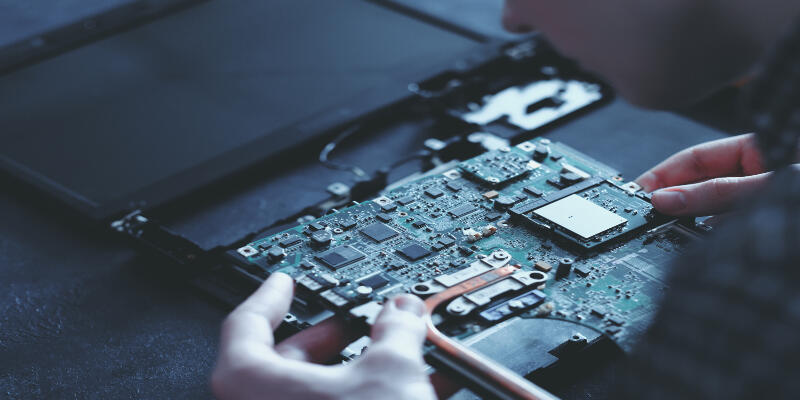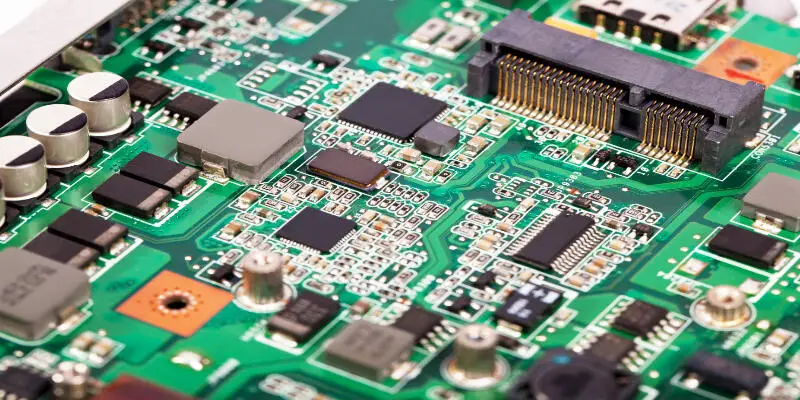Disclaimer: This post may contain affiliate links, meaning we get a small commission if you make a purchase through our links, at no cost to you. For more information, please visit our Disclaimer Page.
One of the most important pieces of hardware in a computer is the motherboard. It connects chips, controllers, ports, and other hardware, allowing them to work together. It works like our brain because, without it, the entire system fails. Because of this, does the motherboard need a cooling system?
The motherboard needs cooling. Cooling the motherboard can prevent damage to the hardware. A motherboard that is too hot can damage the components. Keeping it cool can increase computer lifespan. If you use your computer for heavy workloads, you need to pay attention to the cooling system.
In this post, you will learn about the types of coolers for a motherboard, why they overheat and how to prevent it. If you did not know about these things before, you’ll learn them now. You will also learn what signs to look for when it overheats.
Table of Contents
Does the motherboard need cooling?
As a computer’s central circuit, the motherboard requires cooling to prevent overheating. Because it’s the heart of the computer, the motherboard plays a major role in your computer system.
It allows all components of the computer to communicate with each other. When the motherboard overheats, it disrupts the entire processing system.
One of the reasons that a computer overheats is due to overclocking. It’s a process that increases the clock speed of a CPU. When clock speed increases, it boosts the speed of the computer. A high-speed computer is ideal for gaming and video editing.
But increasing the clock speed also requires increasing the CPU’s voltage.
The increase in voltage helps the computer to be stable even at a higher speed. Yet, a higher voltage means that the temperature of the CPU also increases. So, the cooling system is necessary.
Do motherboards come with coolers?
A motherboard has a heatsink, which acts as a cooling device. Heatsinks cool both the motherboard and the CPU. When it’s attached to a heated device, it manages the device’s heat flow.
Thermal conductivity materials are used for successful heat flow management. In most cases, manufacturers use aluminum and copper as thermal conductivity materials. Through these materials, the heat coming from the source transfers to the heatsink.
When the heat successfully moved to the heatsink, the heat travels throughout it. Then convection and heat diffusion occur. Using a heatsink with a large surface area helps in the increase of heat flow within the device.
There are two types of heatsinks: active and passive. The distinct difference between the two is the presence of a fan in the active heatsink. The active type is lightweight and it’s smaller than the passive type. The active type utilizes the energy from the power supply to function. It’s easy to install and uninstall on the hardware.
On the other hand, the passive type has an extra surface area. It’s built this way to compensate for the absence of a fan. For some reason, the non-fan version is better than the fan-assisted heatsink.
Because there are times the overheating happens when the fan fails to work.
Why is my motherboard getting hot?
Motherboard gets hot for several reasons. One of the reasons is overclocking. If the motherboard still gets hot without overclocking, check where your computer sits.
The area where you place your computer is an important factor to check. Is it placed on an enclosed desk? If your answer is yes, there’s a chance that it has poor airflow that increases the heat inside the system.
If you have an air conditioner in the room, turn it on to lower the temperature. You can also change your desk to an open-air type or without partition.
Using computer programs simultaneously also increases the heat on the motherboard. It’s triggered when the system and programs communicate with each other.
The motherboard uses electrical signals, which increases the CPU’s voltage. To avoid it, don’t open too many programs at the same time.
What temp should your motherboard be?
The standard temperature for a CPU is 50F below when it’s idle. When used for gaming, the acceptable temperature is 85F below. Yet, it’s recommended not to exceed 80F.
But when do you know that the motherboard exceeds the desired temperature?
You can spot it right away when you hear the fan with an unusual noise. It’s an indication that the fan is working at a higher speed to cool down the system. However, beware of a fan that doesn’t create noise, it’s a sign of a broken fan. Obviously, no fan CPU leads to overheating.
As the temperature increases, your computer’s speed decreases. This indicates the computer’s close to shutting down. The BIOS instructs the system to shut down if it’s overheating. It’s a preventive measure to avoid extreme damage to your computer system.
When your computer freezes, it’s a sign that the temperature increases. A blue screen error is also a sign of overheating.
A burning odor occurs when the computer’s fan fails to function. It can be a disaster for your computer as the hardware will catch fire. It can damage the entire hardware.
If you’re using a laptop, you must be more careful. Laptops that are exposed to heat over time can reduce battery life. On the other hand, damaged batteries can overheat.
How can I keep my motherboard cool?
In keeping the motherboard cool, heatsink and fans are your best friends. You can find computers that have both. You can keep your computers in a cool area such as an air-conditioned room.
But if you want to keep your motherboard cool without placing it in an air-conditioned room, invest in a good fan.
It’s better to buy a CPU with two fans. One fan works as an exhaust blowing the hot air away from the device. Another fan draws cool air inside the device.
Ensure that you install an equal number of exhaust and intake fans. It balances the airflow, which eliminates the chance of having too much heat inside the CPU.
The position of the fan also matters. You need to identify which part of the motherboard gets hot faster. When you locate it, add a fan to that area.
You can also increase the number of fans especially when you’re using a gaming computer. Yet, avoid purchasing a CPU with bottom fans. If you bought one, avoid placing it in a carpeted area. Always place it on a hard surface to increase the cool air intake function of the fan.
If adding fans does not lower the temperature of the unit, check for the heatsink. Check if it’s disconnected in the cooling system. A thermal paste can help to fill the gaps.
A dusty fan won’t function at the same level as a clean one – the dust promotes friction and slows the blades. In cleaning the fans, also check the air vents – blocked air vents can result in extreme heat inside the CPU.
If you own a pet, don’t allow your pet to go near the computer. The fur can enter the hardware. Just like a dusty fan, hardware filled with fur blocks the air vents.
Upgrading the components of your computer to an energy-efficient version lowers heat production. You can also look for hard drives that don’t consume too much energy. The newer versions have energy-efficient features. Although it’s not cheap, it’s worth the price. It can help you save money for the long term.
The upgraded versions come with an easy-to-overclock motherboard. But if you can, don’t overclock your computer.
If you’re using a laptop, switching to power save mode can help to reduce energy usage. If you’re using your laptop for long hours, remove the battery and plug it in. It protects your laptop’s battery from potential thermal damage.
Do all motherboards support liquid cooling?
Most manufacturers create motherboards in universal blocks. These blocks are not ideal to cool a motherboard. Unless it’s pre-installed, the liquid cooling system works.
Although new models can cool the CPU and VRM, most models are pricey. If you plan to buy a water-cooled motherboard save at least $399 to $1,100.
But a cooling system doesn’t need to break the bank. Instead of buying a water-cooled motherboard, you can opt for a CPU cooler. You can buy it for as low as $13. On the other hand, the high-end version can cost you $100, which is still cheap.
A CPU cooler has two types: air cooling and liquid cooling. Both types absorb the heat coming from the CPU. Then it moves to the Integrated Heat Spreader and the baseplate of the cooler.
The heat distribution varies depending on the attachment on the cooler’s baseplate.
Heat pipes attached to the baseplate mean that it’s an air cooling system. The heat conducted from the heat pipe moves to the heatsink to expose the heat to cooler air. Then the fan aids in pushing the warm air away.
Baseplates with water blocks have a liquid cooling system. The water block contains a coolant that absorbs the heat. The absorbed heat is transferred to a radiator with the fan’s help, at which point it’s exposed to the air again.
What are the benefits of a cool motherboard?
A cool motherboard is an indication that your computer has a healthy CPU. It means that it won’t crash anytime soon. If it’s at the desired temperature, electrical signals travel in the right direction.
It reaches the correct destination helping the computer interpret the right instruction. It eliminates the chance of your computer crashing.
Maintaining the recommended temperature of the motherboard can benefit you in two ways. It protects the hardware and the data of your computer. For hardware protection, it prevents burning a spot on the motherboard. You want to avoid a charred circuit and capacitors on your motherboard and CPU.
If overheating continues, your computer may shut down but you can smell smoke, which is a sign that something is burning inside.
Keeping the temperature low protects the data on your computer. When the motherboard overheats, it can burn the circuits. In effect, the system stops working and you won’t be able to retrieve your files.
So, using an external drive is sometimes necessary to protect your files.
But it’s a hassle if you do it often. It’s still desirable to save your data on your internal drive.
Conclusion
The computer needs time to rest so it can remain in good condition. Even though it automatically shuts down when it gets too hot, you don’t want to push it to its limits. Remember, the motherboard can detect overheating but not a damaged fan.


